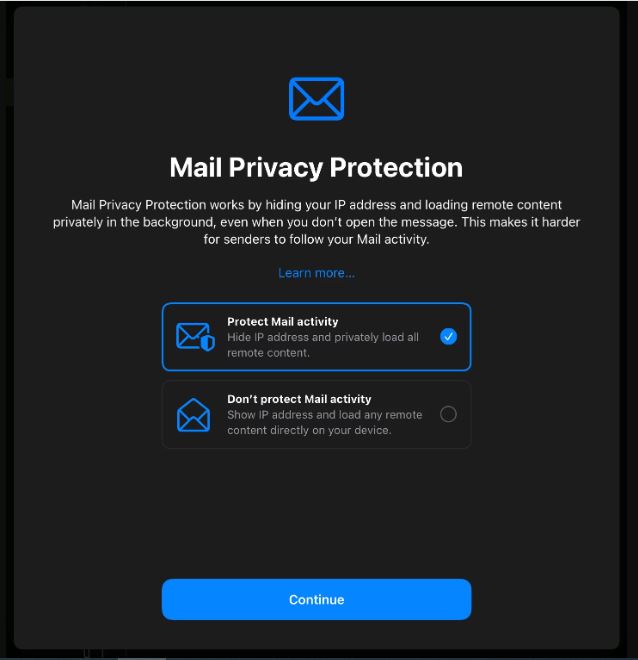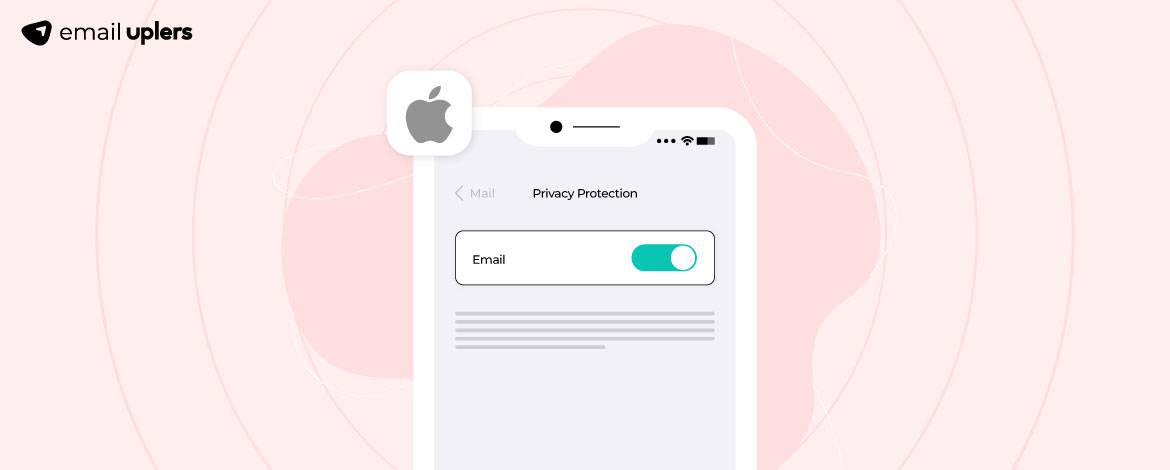In recent years, privacy concerns have taken center stage in the digital landscape. Companies like Apple have been implementing stringent privacy measures to protect user data, resulting in significant changes for marketers. One area where these changes are being keenly felt is in email campaign reports. In iOS 15 and macOS Monterey, Apple introduced Mail Privacy Protection (MPP). This feature hides users’ IP addresses and prevents senders from knowing when an email has been opened. Apple has introduced several privacy features in recent years to enhance mail privacy protection for its users. These privacy measures by Apple aim to give users more control over their data and protect their privacy. However, they can pose challenges for email marketers, as tracking capabilities and personalized targeting may be limited. This blog post explores how Apple’s privacy initiatives are affecting email campaign reports and what marketers should keep in mind.
What is Apple’s Mail Privacy Protection?
Mail Privacy Protection works by hiding your IP address, so that the senders cannot link it to your other online activity or determine your location. This prevents senders from seeing if and when you’ve opened their email. This feature has been introduced in iOS 15 and macOS Monterey by Apple.
This feature would affect any email opened from the Apple Mail app on any device regardless of which email service is used. However, it doesn’t affect other email apps used on Apple devices like the Gmail app on an iPhone.
How does Apple’s Mail Privacy Protection Work?
When someone first opens up the Apple Mail app, they would receive a message asking them to either “Protect Mail activity” or “Don’t protect Mail activity” (neither are pre-selected).
This feature is not selected by default. Users would need to make an active choice. (Except, if you happen to not have Apple Mail as your default email client, Mail Privacy Protection will be turned on by default in your settings before you ever launch the Mail app.) The choice you make is then automatically synced to all devices associated with the same Apple ID.

The Process:
Apple would firstly route emails through a proxy server to pre-load message content including tracking pixels before it would serve to readers. Even if readers don’t actually open those emails.
Initially when the subscriber’s Apple Mail app starts up, it would trigger a download of the email to their device from their email host (e.g., Yahoo or Google). At intervals (could be immediately or could be a couple days later), Apple would download all of the images in the email, creating a copy of the images to a new location on the Apple Privacy Cache. This download is triggered by a proxy server with an IP address assigned to the general region of the subscriber, masking their specific geolocation. This caching process requires Apple to request the images from the email service provider (ESP) which would also include the open tracking pixel which makes the ESP think the email has been opened. However, in reality, it’s still sitting unread in the user’s inbox.
Later if the email is actually opened by the subscriber, it would trigger a request to download and display the email’s images, but instead of coming from the sender’s web host or ESP server, they would be coming from the Apple Cache. So this would hamper in seeing the real opens. This would create issues with identifying who opens, when and where through Apple Mail.
MPP also impacts engagement data gathered from recipients who have configured their email account within the Apple Mail app on any of their devices and enabled MPP. However this isn’t limited to Apple Mail. If a user connects to the Apple Mail app, Gmail or Yahoo! Mail mailboxes could generate false opens if the user has enabled MPP.
How has MPP affected email marketing?
Recipients nowadays are becoming more conscious of their privacy. With the increase in the number of data breaches and privacy scandals, consumers are becoming highly conscious of sharing their personal information. This trend is reinforced by privacy features that are specifically designed to protect consumers. Consumers may not be willing to provide personal information or opt-in to marketing emails if they believe their data will be misused or sold. This could lead to a lower conversion rate and a decrease in overall engagement.
Email marketers are facing tremendous issues.
1. Open rate metrics: Open rate metrics have become less reliable for email lists with subscribers using Apple Mail. Because Apple Mail returns an open when it pre-loads email content, open rates appear to be falsely increased.
2. Audience Segmentation: Audience segmentation or targeting based on the last open date are less relevant, creating issues to target the unengaged subscribers. Also when IP addresses are used for targeting, such as abandoned cart emails or emails targeted at specific locations, it won’t work well anymore. IP addresses of Apple mail users are masked so they can’t be linked to their location or online activity.
3. Automation flows: Automated flows and journeys that rely on triggers related to someone opening an email have become less reliable and need to be re-engineered. This affects campaigns such as lead-nurturing, auto resend, and re-engagement.
4. A/B testing: A/B testing criteria which uses opens to determine the winner or to automatically send out the winner won’t work correctly. The chances are high that the test might receive a large number of unconfirmed opens, which will skew the results.
5. Email content: Email content with dynamic aspects and time constraint promotions would be affected. For example: Countdown timers will show outdated times as the cached version was pulled at sent time and not opened time leading to the countdown timer version showing the subscriber the time remaining from when the email was originally downloaded onto the device. Moreover, other content powered by opens such as local weather or nearest store location also won’t be accurate. MPP has proved detrimental to the state of location-based personalization based on IP addresses. For example, prior to MPP, it was common for retailers and other store-based brands to add a map showing their nearest store location. But since MPP uses proxy servers to regionalize a subscriber’s location, trying to do this now can result in the highlighted store being potentially a hundred miles away from the subscriber’s actual location.
6. Send time optimization: This feature is now inaccurate if your email tool hasn’t reworked their algorithm to exclude opens.
How can email senders adapt to Mail Privacy Protection?
1. Email Service Providers are providing filtering for reporting which would help their customers exclude MPP opens and use “real opens” as a more accurate and reliable measure of overall email engagement.
2. Real-time personalization tools have started providing features of alternatives to contextual personalization by encouraging zero-party and first-party data to personalize content as well as providing generic fallbacks for your Apple Mail audience. For instance, instead of using an IP address to show the nearest store, collect the subscriber’s zip code and use that. Or instead of a countdown timer, showing a broad “sale ending soon” message.
3. Send time optimization (STO) algorithms metrics have been updated to heavily weigh click times. Since clicks have a less frequent signal, STO is now slower to adjust to changing subscriber behaviors. However, because clicks are a stronger sign of intent, more emails are being delivered at times when recipients are likely to take meaningful action, not just open emails.
4. Clicks have become the main focus of automations and email designs. For instance, the loss of reliable opens encouraged many brands to redesign their open-triggered email journeys. Brands have also redesigned their re-engagement campaigns so that they encourage subscribers to click, because just getting an open isn’t a clear signal of re-engagement anymore. MPP has put a premium on driving clicks, which are unaffected by MPP. That has created a need for more A/B testing and optimization of calls-to-action, as well as growing use of non-promotional content in emails.
5. Start by building benchmarks for your click rates. Dig through historical data to orient yourself with your current click metrics. Keep in mind that click rates are always lower than open rates. Start replacing open rates with click rates in any reports or dashboards you frequently review or present.
6. Re-engagement campaigns are used to reach out to dormant subscribers. For example, if a recipient hasn’t opened a message in 2 months, you might consider sending them a re-engagement campaign with promotions to see if they still want to receive your mail. If they don’t open the re-engagement message, you might entertain the idea of removing them from your mailing list. With MPP in the picture, this particular strategy warrants reworking. Remember, clicks are now a reliable signal of positive engagement. If someone is clicking, consider them engaged. However, if your data shows that some recipients open every message but never click, this should be your new signal for non-engagement. Because clicks are harder to come by, and some messages might legitimately be opened but not clicked, it will become more important to nudge your users to take an affirmative engagement action. Focus should also be diverted to using alternative channels like SMS and push.
7. Adapting to new privacy features is important. Senders need to be transparent about data collection and usage practices. Make your subscribers aware about what data you collect, how it is used, and how it is protected. Senders need to stay up to date with the latest privacy features and adjust their email marketing strategy accordingly.
8. Focus should be shifted on measuring different metrics like clicks, return on investment, and list growth. Additionally, you can consider monitoring email forwards, too. If subscribers regularly share your emails with their network, this is a good indicator that you’re providing value to them.
9. Interactive content can help in identifying the engagement level. Including quizzes and surveys in your emails would be a great way to measure engagement, gather feedback, and learn more about the kind of content your subscribers want to see.
10. With clicks being the only reliable way to measure engagement after the launch of Apple Mail Privacy Protection, it’s time to ask subscribers to re-confirm their interest instead of waiting for people to leave. Building an email preference center, which allows subscribers to choose how they receive communications from you, is also a smart idea.
Conclusion
Apple’s privacy measures, such as Mail Privacy Protection, are transforming the way email campaign reports are generated and utilized. Marketers must adapt to these changes by exploring new metrics, leveraging zero and first-party data, and collaborating closely with ESPs. By embracing privacy-focused strategies, marketers can continue to drive successful email campaigns while respecting user privacy in this evolving digital landscape.




Charvi Pavra
Latest posts by Charvi Pavra (see all)
Migrating To A New ESP? Common Pitfalls And How To Overcome Them!
Why and How to Improve your Average Email Response Rate